Rock Holmes: Transformation – Part 4: AFTERLIFE
Rock Holmes: Transformation – Part 0: INTRODUCTION
Rock Holmes: Transformation – Part 1: CHILDHOOD
Rock Holmes: Transformation – Part 2: TRANSFORMATION
Rock Holmes: Transformation – Part 3: RESOLUTION
Rock Holmes: Transformation – Part 4: AFTERLIFE
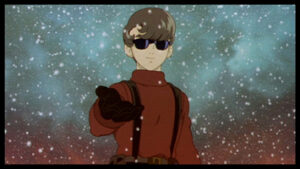
Rock in Metropolis Movie
Section 1: Last Years
Rock had few appearances in Tezuka after Buddha and Black Jack. In Rainbow Parakeet “Twelve Angry Men,” (1981) he cameos as the clever young son of a wealthy man who commits theft just for the thrill of it, and gets what he deserves. In Say Hello to Bookilla (1985) he plays a slapstick role (under the name Makube Rokuro) investigating a haunted TV station and being beaten to a pulp on numerous occasions. Neither of these parts has the intensity of Rock’s earlier parts, as if after making peace with Buddha, Black Jack and Tezuka, Rock is allowed to retire, while Tezuka in turn concentrate on animation, and on new original characters for dark, realistic social commentaries like Adolf.
Rock appears in two late animated specials overseen by Tezuka. In the 1979 TV special Marine Express, is an original animated story, not based on any manga. It is a grand cross-over, cramming in as many notable characters as Tezuka could fit, including Rock, who here plays Astro’s elder brother, son of Dr. Ochanomizu. Rock here is the steadfast pilot of the Marine Express, defender of his passengers, who, after being brought back in time through a time slip, is also the destined savior of the ancient kingdom of Mu, and, after marrying Queen Sapphire, its king. Here Rock helps Shunsaku Ban investigate Skunk’s criminal enterprise, helps and teaches Astro, his brother now rather than his classmate, and rules a kingdom at Sapphire’s side. He is also beaten up and taken prisoner as usual, and spars with Duke Red, who is, for once, not his father but his father’s rival. But there is no dark Rock here, nor transformation – he is a hero. Nothing more complex can be expected from an original story created as charity special, whose goal is to satisfy as many Tezuka fans as possible by giving them their favorite versions of everyone.
In 1980 the Fumoon TV special was created, an animated version of Nextworld, in which Rock’s part, already severely diminished in the original manga, is shortened even more. Rock is never drafted into the army, never trained as a spy, never imprisoned in solitary, broken or enslaved. Instead he remains in Japan, a wealthy and well-connected young man, as usual, who helps Kenichi, Shunsaku Ban and others to investigate the mystery, largely by offering the use of his car, and stays behind when they go to the Fumoon base, preferring to witness the progress of humanity as it faces its supposed end.
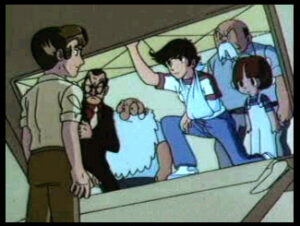
Rock in Fumoon
As with Marine Express all hints of dark Rock, and of Rock’s transforming nature are expunged, and he plays a part which could be played by any young Tezuka hero. We get a hint of Rock’s practical and selfish intelligence at the end when, as humanity gapes up at the rain which has saved them from destruction, he is the only one sensible enough to look for shelter from getting drenched, but we can only conclude that once again Tezuka was unable to stand up to the producers who kept constraining his artistic freedom in his animated works, and forcing him to add audience-pleasing happy endings. It is an understandable failing – to make an enemy of all the executives of the animation industry and become the Black Jack of the animation world is impossible, even for the God of Manga.
Section 2: The Transformer Transformed
Osamu Tezuka passed away on February 9th, 1989, and Rock faded quietly away for twelve years, until 2001 when Japanese audiences found him lounging confidently in the background of the poster for the new film adaptation of what had been, until then, a Kenichi story, Metropolis.
The movie was the brainchild of director Rintaro, who had worked closely with Tezuka throughout his life, and sought in the film, both to create something new, and to resurrect and complete the early science fiction stories which Tezuka, due to the changes made by his editors, was never satisfied with. Rintaro says he decided to add Rock to the Metropolis story in order to have an avatar of darkness to counterpoint Kenichi’s light, an idea no doubt drawn from their parallel development in Nextworld. According to the director, the Rock in the film is not intended to be any specific version of Rock but his own original version combining all former manifestations of the character. Nevertheless, Rintaro’s Rock is clearly closer to some than others, taking his fierce loyalty and military bearing from Phoenix “Future,” and his adoption by Duke Red from the end of Nextworld.
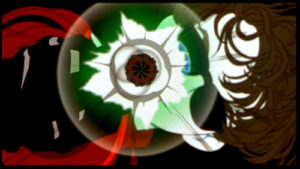
Rock Shoots!
Rintaro believes, he says, that Tezuka would not like the Metropolis movie, because Tezuka believed in a strict boundary between good and evil which the dark and violent but loyal and self-sacrificing Rock of Metropolis does not fit. Rintaro’s original Rock certainly differs from Tezuka’s dark Rock, who would never willingly destroy himself, not even for a parent, since Duke Red in the movie clearly occupies the same relationship to Rock as did the Hallelujah computer whom he abandoned. It may be too much to say that Metropolis‘s Rock is willing to die for a cause because he retains Buddha’s revelation that he deserves to die and the Phoenix’s revelation that he will live again, but of all versions of Rock he certainly seems closest to Makube in “Print Proof” who retains his friendship with Black Jack even after it costs him his life, the version which let Tezuka finally settle the tension he had had toward the character since the unfinished Vampires. Most of Tezuka’s versions of Rock turned definitively from light to dark and never mixed them, but that last Makube did, and establishes a precedent from which Rintaro’s Rock does not diverge too much.
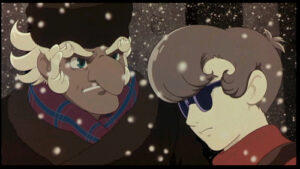
Rock and Duke Red
Metropolis Rock also seems to retain that last Makube’s discernment which let him so easily identify young Black Jack’s true nature. The speed and callousness with which Rock destroys robots, and the ease with which he predicts and manipulates the rebels, indicates that he understands completely the universal principle of the Tezuka universe that a conflict between humans and other, robots in this case, will always lead to war. The ease with which he recognizes Tima as a threat – Tima here taking the place of Astro as the robots’ champion and potential leader in their rebellion – certainly speaks of one who understands how the robot war always begins in Tezuka. And, of course, Metropolis Rock is, like Makube, still a master of disguise.

Masks
The speed with which he identifies how Duke Red’s plans conflict with Duke Red’s interests also suggest that he knows Duke Red’s nature perfectly. It is ironic here, after Duke Red has several times been such a loving and doting father that Rock’s rottenness has derived from being spoiled, to find a cold and strict Duke Red who ignores his adoptive son in favor of a robotic substitute daughter. Still, if this is the Duke Red who adopted Rock at the end of Nextworld to pay for having been responsible for the boy being drafted and corrupted, one could see him becoming cold as he finds his foster-child unable to become anything but a cold soldier. If not, Rock is still more a tool to his father than a child, just as he was to Hallelujah.
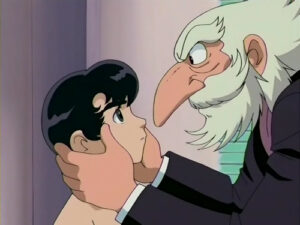
Animated Rock
Section 3: Everyone Gets a Turn
There have been eight more versions of Rock already since the release of Metropolis in 2001, as other artists and directors, given the opportunity to work on re-makes of immortal favorites like Black Jack and Astro Boy continue to explore Tezuka’s most dynamic recurring star. The Black Jack issues “Where’s the Doctor,” “Nadare the Deer,” and “Print Proof,” have been remade in animated form, “Nadare the Deer” also enjoying a manga remake in Black Jack Kuroi Ishi. The “Nadare the Deer” TV episode exemplifies a tendency common, not only in the Black Jack TV series but in TV versions of Tezuka in general; the insertion of happy endings, in this case both Rock’s fiancée and Nadare the deer surviving, though Rock still suffers for the failure of his experiment.
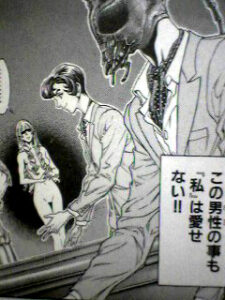
Rock in Black Jack NEO
In the Black Jack NEO adaptation of Pinoko’s origin story, Rock has been inserted as the boyfriend of Pinoko’s highly politically influential twin sister, tormented by the telekinetic attacks of the sentient Pinoko tumor, but still in the ironic position (if you believe Pinoko’s insistence on being the Doctor’s wife) of becoming Black Jack’s brother-in-law.
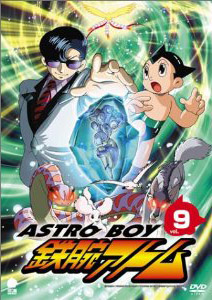
Astro Boy TV Series (2003)
In the 2003 Astro Boy TV series, Rock appears in a very creative hybrid role in episodes 34 and 35, “Shape-shifter” and “Phoenix.” Here Rock is the product of an experiment genetic engineering (as in Phoenix “Future”) possessed of the ability to hypnotize and mind-control people with his eyes (as in Vampires) which he uses to control a shape-shifting alien moopie whom he forces to remain most of the time in dog form as it does his criminal bidding, as he did to Toppei in Vampires. Rock’s goal is to use the technology, based on technology from the Three-Eyed One, of the ruined ancient civilization of Mu, which Rock ruled alongside Sapphire in Seabed Express, to gain access to a mysterious fortress on the moon where he knows the Phoenix holds the secret of immortality.
Rock is determined to become immortal and to use that immortality return to the Earth and gain power as a conqueror. Astro tries to dissuade him, attempting to reconnect the orphan Rock with the memory of the lost mother he believes he, as a genetic experiment, never had, but ultimately Rock fails when the Phoenix refuses to give her gifts to someone so selfish and ambitious, just as she did at their last encounter in Phoenix “Future” twenty-four years earlier. Because Astro, the universal friend, is the star of the show, the story winds up revolving around the quest to induce Rock to embrace sentiment, love and human relationships, which feels preachy on its own, but is the correct solution given that the reason the Phoenix chose Yamanobe over Rock was his capacity to love and care about others, and that the redemption Makube found in “Print Proof” came through finally retaining one loyal friendship. In a sense, this pair of episodes, forty minutes total, covered more than twice as many versions of Rock as the entire Metropolis movie, though for that very reason they feel very incomplete to any viewer who does not know Rock’s full back story.
Also in 2003 and also in the context of Astro Boy Rock was given another new life, this time as a videogame character. The skeleton of the plot of the Astro Boy: OMEGA FACTOR game for the GBA is taken from Seabed Express, with Sharaku as the primary villain. Here, borrowing a plot from the Astro Boy manga, Astro is hired to protect the first robot presidential candidate, who in this case is a robotic version of Rock, from assassination by the real Rock, his creator, who originally made the robot to help him in his presidential campaign but has now been driven out as its popularity overshadows his own. We thus have light Rock as a robot, and dark Rock, his creator, at the same time, almost as we had in Vampires part II as Makube was training the ueko which had copied his image.
Ultimately light, robot Rock is saved, while the darker, human Rock is unmasked, and caught up in the main Seabed Express story as the group are swept back to the ruins of Mu to oppose Sharaku, and redeemed by helping, and marrying, Queen Sapphire. This was the first time a Rock had turned dark and then light again, something Tezuka never permitted and even Metropolis Rock does not do. But the redemption line with the general tone of the Astro Boy game in which even the Phoenix intervenes to help Astro prevent the destruction of humanity, a far kinder universe than the Tezuka’s original with its inevitable cycles of destruction and suffering. Indeed, if we take Rock as a living lesson that sometimes individuals, or humanity, deserve to die, a redeemed Rock can only justly exist in a redeemed universe, one where a kinder, more loving Phoenix will not allow humanity, or Rock, to decay into darkness and oblivion. Tezuka always complained that, in animated adaptations, the executives of the re-make simply refuses to accept Tezuka’s grim original, and he would complain no less about this. At the same time, though, the player of the game, much like the viewer of the new happy-ending Black Jack TV series cannot deny a sense of guilty satisfaction as we see the characters whose suffering we have shared for all these decades survive and find happiness, just this once.
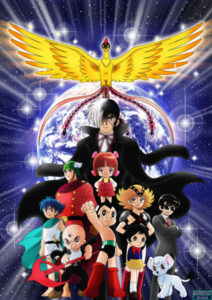
Promo image for Black Jack “Phoenix Version” game for Nintendo DS
Since these new writers who have made Rock, Black Jack, Astro and others their own are not Tezuka, they did not write the cold phoenix who allows civilization after civilization to decay and die, or the grim recurring fates of characters whom even the Buddha can barely comfort. In a sense, then, they have more of a right than Tezuka would to back off and make their new universes a little less cruel. Had Tezuka redeemed Rock he would have been a hypocrite, since he would have destroyed the thorn in the universe’s side which serves as a testament to its (his) cruelty. New authors who do not have the same blood on their hands are a little freer to give him a happy ending.
The new Black Jack movie, “Two Dark Doctors,” was released in late 2005, but has not yet been seen by this author. The film focuses on Black Jack’s rival and dark reflection, the euthanasia specialist Dr. Kiriko. It also features Biwamaru from issue #141 “Death of Hjojisai,” one of the Black Jack issues in which Black Jack is most directly faced with the inescapability of death, and larger questions from Phoenix about the nature of life, relating to the quest for universal understanding which Black Jack inherited from his mentor Dr. Honma, who is also the Phoenix’s chosen pursuer Saruta. And it features Rock, the dark, sunglasses-wearing, gun-wielding, violent Rock we all know, who in this case is also the redeemed, romantic, light Rock who stands tenderly beside his fiancée and fights to live. I do not yet know what precise versions of Rock the film uses, or whether he goes by Rock or Makube, but if anyone can help Black Jack deal with the issues of death which Kiriko and Biwamaru place before him, it is his childhood friend Rock who understood better than anyone what the young Black Jack was and what he would become.
Similarly, Rock will, we know, appear in the upcoming Black Jack Phoenix Version game for the Nintendo DS, which promises to be a multi-series cross-over featuring many of Tezuka’s most notable creations, though, as the promotional image above shows, Rock promises to be possibly the most sinister.
If the authors of re-makes insist on inserting redemption into all Tezuka’s dark stories, particularly dark Rock, there would be no more appropriate place to do so than in a film focusing on the one friend Tezuka thought even Makube would not betray. Rock is not Kenichi who resists all change, nor Astro who grows and learns but remains a friend to all. Rock changes, always toward darkness, renouncing friendship and embracing the necessary utility of evil, as Osamu Tezuka did himself by personally wielding the ZZZ gas in Vampires, and by thereafter writing such dark heroes in many series who solve problems through dark means Astro would never consider. But if Rock were ever to change back from dark to light, if he could have a friend capable of drawing him back from his dark self, it would have to be the Buddha-Doctor Black Jack, Tezuka’s idealized alter-ego, better at sticking to his own path, and at saving those around him, than Tezuka ever could have been.
– END –
Note, this essay was completed in summer 2006.



Leave a Reply